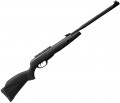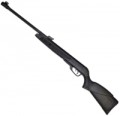Muzzle velocity
The muzzle velocity provided by the rifle - that is, the speed of the bullet as it exits the barrel.
All other things being equal, a higher bullet speed provides greater range and accuracy, and also simplifies aiming at long distances: the bullet flies along a smoother trajectory and requires fewer adjustments in height, and the influence of side winds decreases with increasing speed. On the other hand, this indicator directly affects the price of the rifle; and in some countries, legal restrictions on the ownership of pneumatic weapons are also related to the muzzle velocity of the bullet.
As for specific values, in the weakest modern rifles the initial speed does not exceed
150 m/s, and in the most powerful it can be
300 - 350 m/s or even
more(remember, the speed of sound is 330 m/s). In general, for recreational shooting at short distances, this parameter is not particularly important, and detailed recommendations for choosing pneumatics for more specific situations can be found in special sources. Let us only note that in AEG electric drives (see “Type”) the initial speed extremely rarely exceeds 150 m/s, but this is done solely for safety reasons: such “weapons” are intended for military-tactical games and initially involve shooting at people, and the high speed would be unsafe for players even with protective equipment.
It is also wor
...th considering that this indicator is not strictly defined. In any type of pneumatic it depends on the weight of the bullet (the lighter the faster); therefore, in the characteristics it is usually customary to indicate a certain average velocity for standard ammunition (usually weighing 0.5 g, in AEG - 0.2 g). In addition, in multi-compression rifles the actual speed of the bullet is determined by the degree of inflation, in gas-cylinder rifles it is determined by the ambient temperature, and in PCP models it is possible to achieve higher speeds than declared by replacing the air with a special gas (for example, helium). Nevertheless, this characteristic makes it possible to evaluate the capabilities of the rifle and compare it with other models, including those that differ in type.Muzzle energy
The muzzle energy provided by the rifle.
Muzzle energy is the kinetic energy of the bullet at the exit from the barrel. This energy, in turn, depends on two factors: the mass and the muzzle velocity of the bullet. Thus, this indicator directly describes the overall power of the rifle: higher muzzle energy allows you to effectively fire at longer distances and/or heavier ammunition. On the other hand, an increase in power accordingly affects the cost of weapons.
Note that muzzle energy can be grounds for legal restrictions on the purchase/use of pneumatics. So, in some countries in the post-Soviet space, the maximum value allowed for freely sold rifles is
7.5 J — a special permit will be required to purchase more powerful weapons. And most freely sold rifles in such regions have a power of the
order of 3 – 5 J. Such legal restrictions should be clarified separately. Lower rates are found mainly among “soft” pneumatics for airsoft (airsoft), using 6 mm plastic balls. For such models, a value of more than 2 J is already considered very solid, and in games such rifles are used with a minimum distance limit — for example, 15 m or 20 m (so that a shot from too close a distance does not injure the player).
It is also worth saying that the claimed characteristics of air rifles may, at first glance, not correspond to physical calculations. For example, for a model for the same 7.5 J
..., the initial speed of 250 m/s can be claimed in the characteristics; for a 4.5 mm bullet weighing 0.5 g (the average, most popular weight), this would correspond to an energy of as much as 15.6 J. However, there are no inconsistencies here: such characteristics mean that the muzzle velocity was measured for a lighter bullet (for example, 0 .2 g), which accelerates more strongly at the outlet of the barrel. Accordingly, with heavier ammunition, the speed will be lower; it can be determined using special formulas or online calculators.Sighting device
The type of sighting device that the rifle is initially equipped with. Note that many models allow the installation of other sights - in addition to the standard sighting devices or to replace them. And optics or a collimator can initially be combined with a mechanical sight (front sight + rear sight), which in such cases plays the role of a spare. However, these features are not available in every rifle, so when choosing, it is best to focus on the type of complete sight.
Nowadays, in addition to the traditional
sighting bar with a front sight, you can find diopter,
optical and
collimator sights in air rifles, and in some models, standard sighting devices are completely
absent. Here are the features of each of these options:
— Sighting bar and front sight. Devices in the form of a front sight and a rear sight, which looks like a horizontal bar with a slot; when aiming, you need to combine these devices so that the front sight is visible exactly in the middle of the slot and flush with its edges. Such sights are extremely popular in modern pneumatics: they are extremely simple, inexpensive, compact and reliable, and do not depend on batteries and are quite resistant to impacts and vibrations. In addition, the front sight with a bar does not limit the view as much as optics or a collimator, and is better suited for shoo
...ting at moving targets. The main disadvantage of this option is that a certain skill is required for effective aiming - after all, you need to control not only the aiming at the target, but also the relative position of the front sight and the slot. On the other hand, this point can also be an advantage - in particular, when learning to shoot: having learned to shoot effectively with such devices, the shooter will feel quite confident with other types of sights. It is also worth noting that the front sight and rear sight do not provide any magnification - this makes it difficult to shoot at small and / or distant targets; however, again, this feature is not always an unambiguous disadvantage.
— Diopter sight. A type of mechanical sighting device (i.e. front sight and rear sight) that uses the diopter principle of operation. The rear sight in such devices is a plate with a small hole through which the shooter looks at the front sight. Such a rear sight is easier to use than a traditional bar with a slot, especially for beginners: even without special skills, the shooter subconsciously chooses a position of the eye in which the front sight will be in the center of the hole (as it should be when aiming). In addition, a small hole gives a slight magnification effect and increases the clarity of the target contours, which is especially important at significant distances. On the other hand, diopters significantly limit the view, are poorly suited for low-light conditions and are easily clogged with various contaminants. Therefore, this type of sight is extremely rarely used in airguns - mainly in powerful long-range rifles, primarily for sporting purposes.
— Optical sight. Traditional optical sights in the form of a "spyglass" with a reticle applied to the shooter's field of view. Initially created for high-precision shooting at long distances, mainly at stationary targets; pneumatics are also used in the same role. True, not every pneumatic rifle with optics is a powerful long-range weapon - there are also relatively "weak" models. But even such pneumatics can be a good training aid in high-precision shooting: a short distance in this case can be compensated for by the small size of the target. On the other hand, optics significantly affect the price of the rifle and require careful handling. Of its features, it is also worth noting that such sights necessarily have a certain magnification; due to this, they allow you to better examine small targets, but at the same time limit the field of view. It is also necessary to take into account that the optics are not well suited for off-hand shooting and require careful insertion: the eye must be located exactly on the optical axis of the sight, otherwise the aiming point may not coincide with the point of impact.
— Collimator sight. The working part of a collimator sight is a glass window onto which a luminous aiming mark is projected using a special optical system — a dot, crosshair, circle with a dot, etc. Sights of this type usually do not have magnification and are intended for shooting at short distances, including at moving targets and offhand. So in use, a collimator is similar to a front sight with a rear sight; and its key advantage is its ease of use: there is no need to combine the front sight and the notch, it is enough to find the aiming mark in the window and point it at the target. At the same time, unlike optics, it is not necessary to keep your eye strictly opposite the center of the sight: the parallax effect (see "Adjusting the parallax") in collimators is very weakly expressed, or even absent altogether. The main disadvantage of this type of sight is that they require batteries to operate; In addition, collimators are significantly more expensive than traditional mechanical sights and also require more careful handling (although they are still less delicate than optics).
It is worth noting that such devices are especially popular in airsoft airguns, such as most AEGs (see "Type"): collimators are great for dynamic combat.
— None. The absence of any sighting devices in the original delivery set — there are only mounts for installing such devices. For more information on the different types of mounts, see below; here we note that such a complete set does not allow you to use the rifle "out of the box", but it does give you the opportunity to choose a sight for it at your own discretion, without relying on the manufacturer's choice. This is especially important if you plan to use optics — nowadays a wide variety of such sights are produced for different tasks and scenarios of use. In fact, most air rifles without a sight are designed specifically for installing optics, although the use of collimators is often also allowed; and in airsoft pneumatics, removable front sights with rear sights are also used.
It is worth noting that spring-piston rifles and gas piston models have a specific double recoil that not every scope can withstand - even if it allows use with powerful firearms. So when looking for optics or a collimator for such pneumatics, you should be especially careful - for it you need to choose scopes originally designed for such rifles.Adjustable trigger
The ability to adjust the features of the trigger triggering of the rifle — first of all, the idle (before triggering) stroke of the trigger and the force on the hook. This allows you to optimally adjust the characteristics of the weapon to the personal preferences of everyone: for example, it is usually difficult for beginners to shoot with a tight trigger, but for trained shooters, a too soft hook that “falls through” under the finger may be inconvenient.

